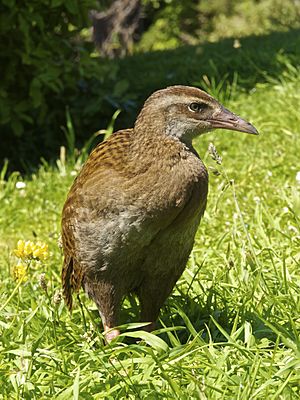Weka facts for kids
Quick facts for kids Weka |
|
|---|---|
 |
|
| In the South Island, New Zealand | |
| Conservation status | |
| Scientific classification | |
| Genus: |
Gallirallus
|
| Species: |
australis
|
 |
|
| Geographic range of the weka | |
The weka (scientific name: Gallirallus australis) is a super interesting bird from New Zealand. It's also known as the Maori hen or woodhen. Weka are special because they are flightless, meaning they can't fly! They belong to the rail family, which includes many birds that live on the ground.
Weka are only found in New Zealand, which means they are endemic to that country. They are sturdy, brown birds, about the size of a chicken. You can find four different types, or subspecies, of weka. These clever birds mainly eat small creatures like insects and worms, along with tasty fruits they find.
Contents
What is a Weka?
Weka are medium-sized birds, usually growing to about 50 to 60 centimeters (20 to 24 inches) tall. They have strong legs and feet, which help them run fast and explore their surroundings. Their feathers are a mix of brown and black, helping them blend in with the forest floor. They also have a long, strong beak that they use for digging and finding food.
Why Can't Weka Fly?
Millions of years ago, New Zealand didn't have many land predators like cats or stoats. Because of this, some birds, like the weka, didn't need to fly to escape danger. Over time, they lost the ability to fly. This is why they are so good at walking and running!
Where Do Weka Live?
Weka live in many different places across New Zealand. You can find them in forests, grasslands, and even along the coast. They are very adaptable and can live in both wet and dry areas. They like places where there's plenty of cover, like thick bushes, to hide from predators and find food.
Weka Homes
Weka often make their nests on the ground, hidden among plants or under logs. They are very territorial, which means they like to have their own space and will defend it from other weka.
What Do Weka Eat?
Weka are omnivores, which means they eat both plants and animals. Their diet is quite varied!
- Insects and Worms: They love to dig in the soil to find grubs, beetles, and earthworms.
- Fruit and Seeds: Weka also enjoy eating berries and seeds from native plants.
- Small Animals: Sometimes, they might eat small lizards, frogs, or even eggs from other birds' nests.
- Scavenging: They are also known to scavenge for food, meaning they will eat scraps or dead animals they find.
Their strong beaks are perfect for digging and picking up all sorts of food.
Weka Behavior
Weka are very curious and bold birds. They are not shy and will often come close to people, especially if they think there might be food around. This curiosity can sometimes get them into trouble!
Are Weka Noisy?
Yes, weka can be quite noisy! They make a range of calls, especially at dawn and dusk. Their calls can sound like "wee-ka" or "coo-et," which is how they got their name. They use these calls to communicate with each other, warn of danger, or mark their territory.
Weka Families and Life Cycle
Weka usually breed during the warmer months, from August to January.
Nesting and Eggs
The female weka lays between two to six eggs in a nest on the ground. Both parents help to incubate the eggs, which means keeping them warm until they hatch. This usually takes about a month.
Weka Chicks
When the chicks hatch, they are covered in soft, dark down feathers. They can leave the nest soon after hatching and follow their parents. Both the mother and father weka take care of the chicks, teaching them how to find food and stay safe. Weka chicks grow up quickly and become independent in a few months.
Conservation of Weka
Unfortunately, weka are considered a vulnerable species. This means their numbers are decreasing, and they need our help to survive.
Threats to Weka
The biggest threats to weka are:
- Predators: Animals like stoats, ferrets, cats, and dogs, which were brought to New Zealand by people, hunt weka and their chicks.
- Habitat Loss: As more land is used for farming or building, the places where weka live shrink.
- Cars: Weka often get hit by cars when they cross roads.
How We Can Help
Many people in New Zealand are working to protect weka. This includes controlling predators, protecting their habitats, and educating people about these unique birds. By learning about weka, you can help spread awareness and protect them too!
Images for kids
-
A buff weka at Willowbank Wildlife Reserve, Christchurch
-
A ruffled weka on Chatham Island
See also
 In Spanish: Rascón weka para niños
In Spanish: Rascón weka para niños





